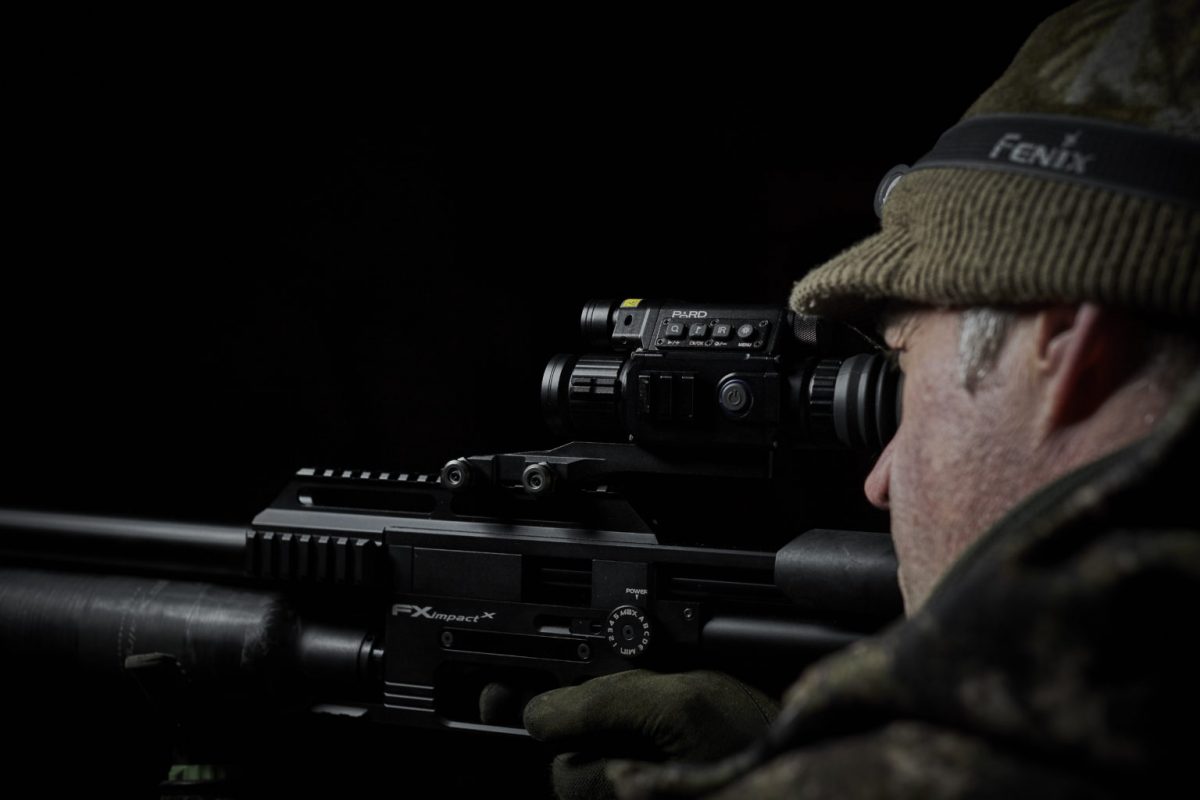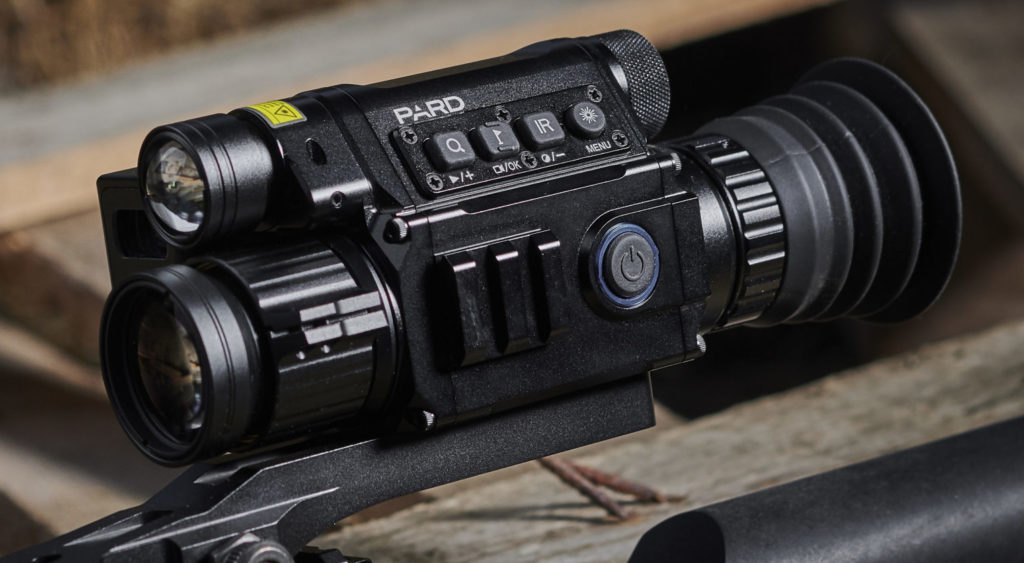Pard NV008P LRF scope
Mat Manning eyes up the Pard NV008P LRF; a compact digital day and night scope that that’s big on features and value.

Pard NV008P LRF scope
Overall Rating: 90%
Modern night vision equipment has had a huge impact on after-dark pest control over recent years, enabling hunters to pick off unsuspecting critters from the cover of darkness.
I have witnessed the difference technology can make when targeting skittish nocturnal quarry, and night vision optics have given a huge boost to my results when targeting rabbits and rats after nightfall.
Some shooters have been reluctant to make the transition from traditional lamping methods, many of them put off by sophisticated gear that is bulky, expensive and complicated to use. Cue the Pard NV008P LRF; a neat little night vision unit that offers a solution to just about all of those concerns.
Pard NV008P LRF: Key specifications
Supplied by: Sportsman Gun Centre (www.sportsman guncentre.co.uk)
Model: Pard NV008P LRF
Price: £899.99
Length: 175mm (including eyecup)
Weight: 450g
Magnification: 6.5-13x
Focus: 3m to infinity
Eye relief: 45mm
Features: Integral rangefinder, day and night use, video recording, onboard IR, gyroscope, e-compass, multi-reticle, high-definition screen
First impressions of the Pard NV008P LRF
Retailing for £899.99, this infrared optic still isn’t exactly cheap, but it is remarkably affordable when compared with its counterparts, many of which it manages to outperform in all departments.
Of course such an outlay always has to be a considered purchase, balancing the cost against the gains, and when you consider this Pard’s features, ease of use and compact proportions, it does tend to come out rather well.
The first thing to strike me about the NV008P LRF was just how small it is – it weighs just 450 grams and is only 175mm long including the soft rubber eyecup. I’m used to using pretty bulky night vision gear, so these diminutive proportions were a very nice surprise.

The micro-SD card slot and USB charging point are accessed by unscrewing the weatherproof side cap
It could be argued that given its setback positioning, such a lightweight optic can make an airgun feel a bit light at the front end, but you can’t have everything and I’ll take the weight reduction – especially on nights when I have to haul my gear miles over steep hills in pursuit of wary rabbits.
The Pard comes supplied in a nice hard case, along with the rechargeable Li-ion battery it runs on and a USB charging cable. You also get a set of easy-to-follow instructions, a Picatinny-type mount and the required tools to fit it – the kit even includes some neat little shims to ensure that you don’t have problems with reticle alignment when zeroing.
After attaching the NV008P LRF to my FX Impact MkII and giving it a full charge, I couldn’t wait to fire it up. A long press on the standby button switches the unit on, and you then use the dioptre adjustment ring at the rear to get the display into pin-sharp focus for your eye. With this done, it’s time to get down to the interesting stuff.
Features and function of the Pard NV008P LRF
The Pard’s main controls are in the form of four buttons on the top-left of the unit. The one closest to your eye is the Menu button (more about that later) and the next one along is the IR button. A long press of this shifts you between the colour daytime display and the monochrome infrared night vision display.
Once you’re in night vision mode, short presses of the IR button increase and decrease the intensity of the onboard infrared illuminator, which has three power levels or can be switched off completely. Further adjustment can be made to the infrared beam by pulling the collar around its front lens in and out to move between flood and spot.
In normal operating mode, the third button along activates the integral rangefinder. Having a built-in rangefinder on a night vision unit may sound like something of a luxury, but it’s a feature that I would struggle to give up. Judging range when looking at a fairly flat NV image is tricky to say the least.
Some shooters may be happy to guesstimate the distance to their target, but this can result in surprisingly wide misses if you get it wrong: even when ratting over relatively close ranges, I need to apply about 30mm holdover at 10m and about the same in holdunder at 20m.
Using the rangefinder on the NV008P LRF is a doddle; give the Rangefinder button a short press and then hold the onscreen rangefinder cursor over your target – the distance to your mark then appears next to the cursor.
You can see the flickering beam of the rangefinder when in night vision mode, and you can even recalibrate the cursor to ensure that it’s precisely aligned for when you can’t see it in daylight. The process is harder to describe than it is to carry out, but there are some great tutorials on YouTube.
The fourth button – the one furthest from your eye – controls the zoom. With the standard magnification set at 6.5x you can boost it to 13x with a quick press of this button. Magnification can be increased further by accessing the Picture-in-Picture (PIP) function with a quick press of the Menu button.
Most shooters will probably leave the main menu alone for most of the time, but you need to use it for initial zeroing. Give the Menu button a long press and then use the IR button to scroll down the list to Reticle Adjustment. Select this menu with a quick press of the Rangefinder button and you can now pick from a choice of reticle styles and colours.
To zero, enter the Reticle Adjustment mode and take a shot at your paper target. The selected mode enables you to use the Zoom and IR buttons, which serve as + and – buttons in this setting, to adjust the reticle along its X and Y axis.
Hold the reticle on the bullseye you were aiming for and press the + button. This freezes the image so you no longer have to hold the gun still to keep the reticle on target. All you have to do now is use the + and – buttons to steer the reticle to where the pellet struck. The Rangefinder button now serves as an OK button to save your changes.

It doesn’t take long to master this Pard’s basic controls, which are navigated via four soft-touch buttons

The NV008P LRF comes supplied with a Picatinny-type mount for quick and secure attachment

The NV008P LRF comes supplied with a Picatinny-type mount for quick and secure attachment
Pard’s zeroing function theoretically enables you to zero with just a single shot, though it is worth running a few more pellets through just in case it
needs fine-tuning after the initial adjustment. What I really like is that you can save several profiles with different zeros for different setups and different hunting scenarios.
For many of us, zeroing is about as far as we have to delve into the menu choices, but there are numerous options if you want to go deeper. Scroll on down through the menu selections and you can tweak exposure, image and IR brightness, change default magnification, switch between yards and metres for range readings, set date and time, and activate wi-fi and auto recording – the list goes on.
The ability to record video is a boon for shooters who want to capture and share footage from their hunting trips, and I was very impressed with the quality of the video I recorded.
You need to obtain your own micro-SD card, which is housed in a slot beneath the cap on the right-hand side of the unit – the USB charging point can also be found here.
Video recording can be manually activated by a long press on the Rangefinder button. A red dot icon and timer in the top-right of the screen confirm that you’re rolling, and another long press stops the recorder.
In practice
I am the sort of shooter who likes to leave the fiddly stuff alone once I’m in the field, and you can pretty much do that with this Pard.
The only control that really comes into play once you’re up and running is the Rangefinder button, and that quickly becomes second nature. The only other rolling adjustment you’re likely to need to make is focusing the main image, and that’s easily done with a twist of the objective lens ring which, just like using the rangefinder, soon becomes very intuitive.
Even if you aren’t a whizz with technology, the NV008P LRF has clever features that you can take advantage of without having to scroll through menus. Thanks to an onboard gyroscope, the horizontal angle is displayed on the right of the sight picture.

Fast and accurate distance readings to target come courtesy of a discreet onboard rangefinder
This effectively shows you whether you are canting the gun to the left or right; a habit that can make a big difference to point of impact, especially if you shoot a high-sided bullpup. Elevation is displayed on the left, providing a clear indication of how steep the upward or downward angle of the shot is, so you can compensate as necessary.
Battery run-time is an important consideration when you’re out on the graveyard shift. The rechargeable 3.7v Li-ion battery is said to have a runtime of up to eight hours, but you can expect that to reduce the more you draw on it by using additional features such as the IR illuminator and rangefinder.
Very cleverly, this Pard enables you to reduce battery consumption by switching to standby mode with a quick press of the Power button –
give it another press and you are immediately back in action.
I have used the Pard NV008P LRF in night mode with frequent rangefinding for well over three hours taking advantage of the standby mode and it didn’t run out of power. The battery is so small that it would be easy enough to carry a fully charged spare on longer sessions.
Overall image quality is exceptional considering this Pard’s price point. Detection range with the onboard illuminator is good out to 200m and you could always give it a boost and extend battery life by fitting a more powerful external IR torch.
Build quality is also impressive and although I didn’t manage to subject the test unit to a rainy night, it is stated as being waterproof. Another thing I really like is that this optic looks and handles very much like a conventional scope, and it also produces a very good colour image by day.
It is difficult to find fault with this remarkable little night vision unit. As I said at the outset, its price tag does mean that it’s an investment that needs to be justified, but when you consider that it does just about everything than any airgun shooter could want from an infrared NV optic, I think that outlay represents remarkable value that is very hard to beat.









